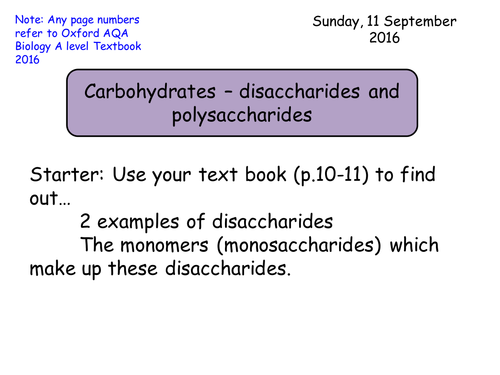
Lesson plan complete with activities (e.g practise questions and exam style questions) to achieve the following objectives:
1) Describe how monosaccharide's are linked together to form disaccharides - starter: identify two disaccharides and what monomers they are made from; mono- di- poly-saccharide recap from previous lesson (1.2 Carbohydrates - monosaccharides); step-by-step visual outline of the condensation reaction; table of disaccharides to complete; condensation and hydrolysis practice questions (worksheet - hidden slide - just print!).
2) Outline how to test for non-reducing sugars & starch - discussion point and reference back to previous lesson (1.2 Carbohydrates - monosaccharides) where practical was conducted for testing reducing sugars then hydrolysis of non-reducing sugars.
3) Explain and illustrate how a-glucose is linked together to form starch in polymerisation reactions - exam style question; overview of starch, cellulose and glycogen, practise questions on amylose and amylopectin (worksheet - hidden slide - just print!).
The lesson finishes with a self-evaluation where pupils can reflect on their learning objectives and identify their corresponding level.
1) Describe how monosaccharide's are linked together to form disaccharides - starter: identify two disaccharides and what monomers they are made from; mono- di- poly-saccharide recap from previous lesson (1.2 Carbohydrates - monosaccharides); step-by-step visual outline of the condensation reaction; table of disaccharides to complete; condensation and hydrolysis practice questions (worksheet - hidden slide - just print!).
2) Outline how to test for non-reducing sugars & starch - discussion point and reference back to previous lesson (1.2 Carbohydrates - monosaccharides) where practical was conducted for testing reducing sugars then hydrolysis of non-reducing sugars.
3) Explain and illustrate how a-glucose is linked together to form starch in polymerisation reactions - exam style question; overview of starch, cellulose and glycogen, practise questions on amylose and amylopectin (worksheet - hidden slide - just print!).
The lesson finishes with a self-evaluation where pupils can reflect on their learning objectives and identify their corresponding level.
Get this resource as part of a bundle and save up to 56%
A bundle is a package of resources grouped together to teach a particular topic, or a series of lessons, in one place.
Something went wrong, please try again later.
This resource hasn't been reviewed yet
To ensure quality for our reviews, only customers who have purchased this resource can review it
Report this resourceto let us know if it violates our terms and conditions.
Our customer service team will review your report and will be in touch.
£2.90
